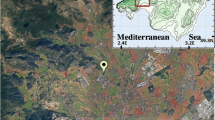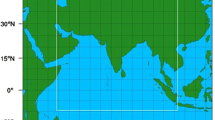Abstract
We used regional climate model simulations of the East Asian Summer Monsoon (EASM) to study diurnal-to-seasonal characteristics of the surface energy balance and temperature, and their relationships to clouds and surface soil moisture. Simulations were performed for the period May through September 1988 and 1989, 2 years with significant differences in observed surface air temperature, radiation, and clouds over the Yangtze-Huai River Valley (YHRV), which are realistically reproduced by the model. Differences in daytime evolutions of the YHRV surface net radiation, heat fluxes, and surface air temperature between 2-year summers result mainly from fluctuation of shortwave cloud radiative forcing. Clouds dominate daily variability of the YHRV surface net solar radiation, surface net radiation, and latent heat, generally accounting for above 80% of the total variances. Consequently, they are more effective in damping the diurnal temperature range by reducing daytime maximum temperature as compared to surface soil moisture. Both clouds and soil moisture exhibit small effects on nighttime minimum temperature, which is largely controlled by the greenhouse effect of the atmospheric water vapor. Surface energy balance components and temperature evolve with the march of EASM, which is quite different between 2 years. The comparative analyses of observations and other available data can generally validate the major conclusions from the simulations.











Similar content being viewed by others

References
Betts AK (2004) Understanding hydrometeorology using global models. Bull Am Meteor Soc 85:1673–1688
Betts AK (2007) Coupling of water vapor convergence, clouds, precipitation, and land-surface processes. J Geophys Res 112:D10108. doi:10.1029/2006JD008191
Betts AK, Ball JH, Bosilovich M, Viterbo P, Zhang YC, Rossow WB (2003) Intercomparison of water and energy budgets for five Mississippi sub-basins between ECMWF reanalysis (ERA-40) and NASA Data Assimilation Office, fvGCM for 1990–1999. J Geophys Res 108(D16):8618. doi:10.1029/2002J0003127
Betts AK, Desjardins R, Worth D (2007) Impact of agriculture, forest and cloud feedback on the surface energy balance in BOREAS. Agric Forest Meteorol 142:156–169
Chen M, Pollard D, Barron EJ (2005) Hydrologic processes in China and their association with summer precipitation anomalies. J Hydrol 301:14–28
Cheng CT, Wang WC (2005) Cloud parameterizations in SUNYA regional climate model for the East Asia summer monsoon simulation. Terr Atmos Ocean Sci 16:959–987
Dai A, Del Genio AD, Fung IY (1997) Clouds, precipitation, and temperature range. Nature 386:665–666
Dai A, Trenberth KE, Karl TR (1999) Effects of clouds, soil moisture, precipitation and water vapor on diurnal temperature range. J Clim 12:2451–2473
Dickinson RE, Errico RM, Giorgi F, Bates GT (1989) A regional climate model for western United States. Clim Change 1:383–422
Ding YH (1994) Monsoons over China. Kluwer Academic Publisher, Dordrecht, p 419
Ding YH (2004) Seasonal march of the East Asian summer monsoon. In: Chang CP (ed) The East Asian monsoon. World Scientific Publisher, Singapore, p 564
Ding YH, Chan JCL (2005) The East Asian summer monsoon: an overview. Meteorol Atmos Phys 89:117–142
Ding YH, Sikka DR (2006) Synoptic systems and weather. In: Wang B (ed) The Asian monsoon. Springer, New York, pp 131–201
Dirmeyer PA, Guo Z, Gao X (2004) Comparison, validation, and transferability of eight multiyear global soil wetness products. J Hydrometeor 5:1011–1033
Dudek MP, Liang XZ, Wang WC (1996) A regional climate model study of the scale dependence of cloud-radiation interactions. J Clim 9:1221–1234
Galli C, Nardino M, Levizzani V, Rizzi R, Georgiadis T (2004) Radiative energy partition and cloud radiative forcing at a Po valley site. Atmos Res 72:329–351
Giorgi F (1990) Simulation of regional climate using a limited area model nested in general circulation model. J Clim 3:941–963
Gong W, Wang WC (2000) A regional model simulation of the 1991 severe precipitation event over Yangtze-Huai river valley. Part II: Model bias. J Clim 13:93–108
Gong W, Wang WC (2007) SUNYA regional climate model simulations of East Asia summer monsoon: effects of cloud vertical structure on the surface energy balance. Terr Atmos Ocean Sci 18:493–514
Grell AG, Dudhia J, Stauffer DR (1994) A description of the fifth-generation Penn State/NCAR mesoscale model (MM5). NCAR Tech. Note NCAR/TN398+STR, National Center for Atmospheric Research, Boulder, CO, pp 117
Hagemann S, Machenhauer B, Jones R, Christensen OB, Deque M, Jacob D, Vidale PL (2004) Evaluation of water and energy budgets in regional climate models applied over Europe. Clim Dyn 23:547–567
Hirasawa N, Kato K, Takeda T (1995) Abrupt change in the characteristics of the cloud zone in subtropical East Asia around middle of May. J Metor Soc Jpn 73:221–239
Kain JS, Fritsch JM (1993) Convective parameterization for mesoscale models: the Kain-Fritsch scheme. In: Emanuel KA, Raymond DJ (eds) The representation of cumulus convection in numerical models. Amer Meteor Soc, pp 246
Kiehl JT, Hack JJ, Bonan GB, Boville BA, Williamson DL, Rasch PJ (1998) The national center for atmospheric research community climate model: CCM3. J Clim 11:1131–1149
Koster KD, Milly PCD (1997) The interplay between transpiration and runoff formulations in land surface schemes used with atmospheric models. J Clim 10:1578–1591
Leung LR, Ghan SJ (1998) Parameterizing subgrid orographic precipitation and surface cover in climate models. Mon Wea Rev 126:3271–3291
Leung LR, Zhong S, Qian Y, Liu Y (2004) Evaluation of regional climate simulations of the 1998 and 1999 East Asian summer monsoon using the GAME/HUBEX observational data. J Metor Soc Jpn 82:1695–1713
Li H, Robock A, Liu S, Mo X, Viterbo P (2005) Evaluation of reanalysis soil moisture simulations using updated Chinese soil moisture observations. J Hydrometeor 6:180–193
Liang X et al (1998) The project for intercomparison of land-surface parameterization schemes (PILPS) phase-2c Red-Arkansas river basin experiment: 2. Spatial and temporal analysis of energy fluxes. Global Planet Change 19:137–159
Lu R, Li Y, Dong B (2006) External and internal summer atmospheric variability in the western North Pacific and East Asia. J Meteor Soc Jpn 84:447–462
North GR, Bell TL, Cahalan RF, Moeng FJ (1982) Sampling errors in the estimation of empirical orthogonal functions. Mon Wea Rev 110:699–706
Notaro M, Wang WC, Gong W (2006) Model and observational analysis of the Northeast US regional climate and its relationship to the PNA and NAO patterns during early winter. Mon Wea Rev 134:3479–3505
Pitman AJ, McAvaney BJ, Bagnoud N, Cheminat B (2004) Are inter-model differences in AMIP-II near surface air temperature means and extremes explained by land surface energy balance complexity? Geophys Res Lett 31:L05205. doi:10.1029/2003GL019233
Qian W, Chen D, Zhu Y, Shen H (2003) Temporal and spatial variability of dryness/wetness in China during the last 530 years. Theor Appl Climatol 76:13–29
Qian Y, Leung LR (2007) A long-term regional simulation and observations of the hydroclimate in China. J Geophys Res 112:D14104. doi:10.1029/2006JD008134
Rossow WB, Schiffer RA (1999) Advances in understanding clouds from ISCCP. Bull Am Meteor Soc 80:2261–2287
Sellers PJ, Mintz Y, Sud YC, Dalcher A (1986) A Simple Biosphere Model (SiB) for use within general circulation models. J Atmos Sci 43:505–531
Tao S, Chen L (1987) A review of recent research on the East Asian summer monsoon in China. In: Chang CP, Krishnamurti TN (eds) Review of monsoon meteorology. Oxford University Press, Oxford, p 353
Tian B, Ramanathan V (2002) Role of tropical clouds in surface and atmospheric energy budget. J Clim 15:296–305
Uppala SM et al (2005) The ERA-40 re-analysis. Q J R Meteorol Soc 131:2961–3012
Wang B, Wu R, Fu X (2000a) Pacific-East Asian teleconnection: how does ENSO affect East Asian climate? J Clim 13:1517–1536
Wang WC, Gong W, Wei H (2000b) A regional model simulation of the 1991 severe precipitation event over the Yangtze-Huai river valley. Part I: Precipitation and circulation statistics. J Clim 13:74–92
Wang X, Key JR (2003) Recent trends in arctic surface, cloud, and radiation properties from space. Science 299:1725–1728
Wang Y, Sen OL, Wang B (2003) A highly resolved regional climate model (IPRC-RegCM) and its simulation of the 1998 severe precipitation event over China. Part I: Model description and verification of simulation. J Clim 16:1721–1738
Wang WC, Gong W, Kau WS, Chen CT, Hsu HH, Tu CH (2004) Characteristics of cloud radiation forcing over East Asia. J Clim 17:845–853
Willmott CJ, Matsuura K (1995) Smart interpolation of annually averaged air temperature in the US. J Appl Meteor 34:2577–2586
Xue Y, Sellers PJ, Kinter JL, Shukla J (1991) A simplified biosphere model for global climate studies. J Clim 4:345–364
Xue Y, Zeng FJ, Schlosser CA (1996) SSiB and its sensitivity to soil properties—a case study using HAPEX-Mobilhy data. Global Planet Change 13:183–194
Zhang Y, Rossow WB, Lacis AA, Oinas V, Mishchenko MI (2004) Calculation of radiative fluxes from the surface to top of atmosphere based on ISCCP and other global data sets: refinements of the radiative transfer model and the input data. J Geophys Res 109:D19105. doi:10.1029/2003JD004457
Acknowledgments
We would like to thank Wei Gong for preparing initial and boundary conditions for the model simulations and valuable discussions. Caiming Shen provided useful comments on the early draft. Insightful comments and suggestions by anonymous reviewers are appreciated. These substantially improved the earlier version of the manuscript. The work was supported by grants (to SUNYA) from the office of Biological and Environmental Sciences, Department of Energy, and the Programs of Climate Dynamics and Atmospheric Chemistry, National Science Foundation.
Author information
Authors and Affiliations
Corresponding author
Rights and permissions
About this article
Cite this article
Zhang, J., Wang, WC. Diurnal-to-seasonal characteristics of surface energy balance and temperature in East Asian summer monsoon simulations. Meteorol Atmos Phys 102, 97–112 (2008). https://doi.org/10.1007/s00703-008-0009-0
Received:
Accepted:
Published:
Issue Date:
DOI: https://doi.org/10.1007/s00703-008-0009-0



